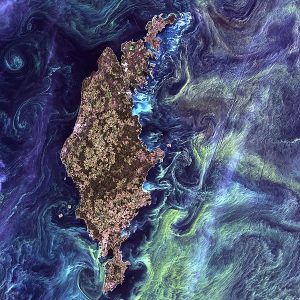The consequences of harmful algal blooms and their production of paralytic shellfish toxins
by Laurel Zaima, RJD intern
Harmful algal blooms (HABs) are a large concern for many who live on the coasts. People are told to avoid eating local seafood and contact with the contaminated water. However, the consequences of HABs extend much further than many people realize. HABs are associated with high fish mortality, which disturbs the entire effected marine and coastal ecosystem. During HABs, there are high cell densities of toxin-producing phytoplankton species. These phytoplankton produce a paralytic shellfish toxin (PST) and they are easily ingested by planktivorous fish or filter-feeding organisms. Once the toxin has entered the food web, PSTs can impact multiple trophic levels. (Picture 1: An expansive harmful algal bloom is prominently seen off the coast of Gotland, a Swedish Island in the Baltic Sea.) PSTs are a worldwide concern because they are concentrated and abundant near the coasts and have detrimental affects on aquaculture, fisheries, human health, industries, and economies. In the scientific paper, Impact and effects of paralytic shellfish poisoning toxins derived from harmful algal blooms to marine fish, Costa (2014) assess the fish contamination, fish mortality, and the ecosystem-wide implications of these toxins in order to better understand and help to better manage the damaging effects of PSTs.
Paralytic shellfish toxins are produced in the marine environment by nine dinoflagellate species. Each of the PSTs have slight differences in the structure of their functional groups, which results in different toxicity levels. (Picture 2: The chemical structure of the paralytic shellfish toxins (PSTs)). Fish that are exposed to PST exhibit irregular swim and motor behaviors, such as swimming on their sides or upside down and gaping at the surface. With extensive exposure to PSTs, the toxin causes subsequent paralysis in the muscles. Therefore, PSTs prevent fish from effectively foraging or avoiding predators. Ultimately, the most common result of the toxicity is death.
Fish mortality associated with PSTs have been reported worldwide. Fish species involved in the toxic episodes include planktivorous fish that feed directly on the toxic algae, planktivorous fish that ingested contaminated zooplankton that have fed on the toxic algae, predators species that have fed on the contaminated fish or shellfish, and fish that are artificially fed but were directly exposed to the toxic algae. The PSTs that are produced by harmful algal blooms can modify the predator-prey interactions that can lead to a cascading affect on the coastal food web and community structures in the marine systems. PSTs hold consequences for organisms at various trophic levels from the ability to initiate a top-down or bottom-up trophic cascade. Humans have also been contaminated by PSTs in various countries from ingesting toxic fish. After people were directly affected by PSTs, action towards algal management was implemented in several countries. Countries in South-East Asia have employed laws that enforce the identification and count of the toxic phytoplankton in seawater, a measure of the toxicity in the shellfish, and a constant monitoring of the marine toxins in planktivorous fish before declaring the local fish acceptable for consumption.
The neurotoxic paralytic shellfish toxins have negative impacts on the fish populations and any associated marine and terrestrial organisms. PSTs have an apparent significance on the function of the ecosystem, and therefore, there is an increasing importance in understanding, managing and monitoring the issue. In terms of ecosystem-based management, it is imperative that fish are properly characterized by their levels of PST exposure from direct consumption and through potential intermediate vectors in order to keep seafood consumers safe from the toxins.
Impact and effects of paralytic shellfish poisoning toxins derived from harmful algal blooms to marine fish
P Reis Costa – Fish and Fisheries, 2014





Leave a Reply
Want to join the discussion?Feel free to contribute!